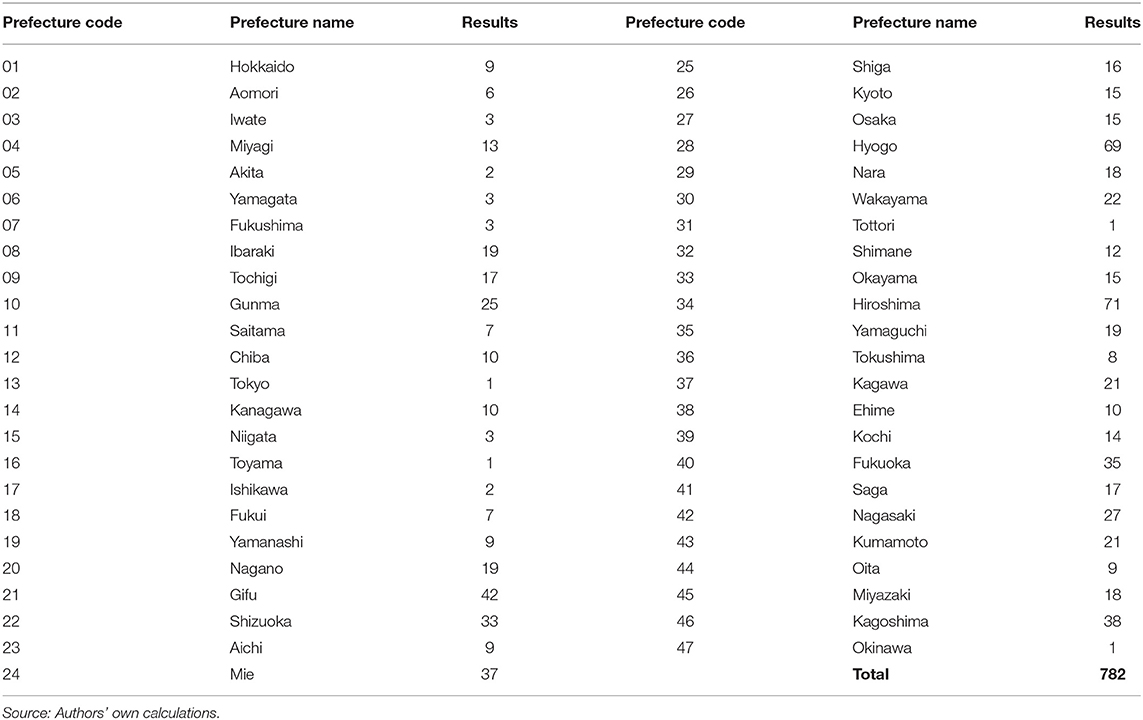- Graduate School of Advanced Integrated Studies in Human Survivability, Kyoto University, Kyoto, Japan
Following the global trend of climate change mitigation, Japan has been rapidly increasing its share of renewable energy, in particular, its share of solar energy. However, Japan has limited flat land area that is suitable for solar photovoltaic (PV) power generation and a high risk of natural disasters. There is a possibility that some of its newly built solar power plants are located in areas where landslides and floods are likely to occur. Therefore, it is important to study the locations for solar PV from the perspective of disaster risk management. Previous studies have reported a number of incidents where solar PV installations were damaged as a result of natural disasters. One study utilized geographical analysis technology to reveal the overlapping of solar PV powerplant locations and disaster-prone areas in Fukuoka prefecture in Japan. However, to our best knowledge, no previous research about the solar PV locations' hazard risks has been done on a national scale. This paper investigates the risks stemming from landslides and floods for the existing solar PV power plants in Japan. We compare the geographical data of disaster risks in Japan with the location data of solar PV power plants to investigate the number of solar PV power plants located in disaster risk areas. Our results show that the shares of medium and large-scale solar PV power plants located in areas where landslides and floods are likely to occur are about 8.5 and 9.1% respectively.
Introduction
The number of solar photovoltaic (PV) power plants in Japan has been increasing in recent years. Since the introduction of the Feed-in Tariff system in 2012 to promote renewable energy, solar PV power generation, which has a relatively short set-up process, in particular has played a central role (Figure 1).
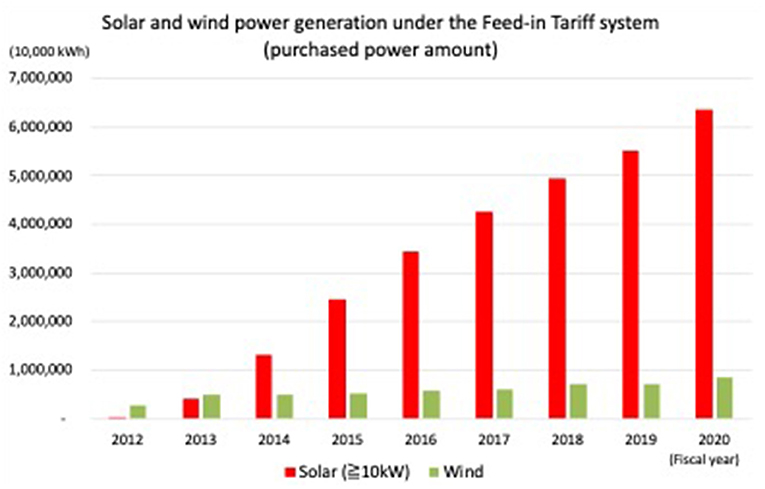
Figure 1. Solar and wind power generation under the Feed-in Tariff system in Japan in 2012–2020. Source: Data from the Agency for Natural Resources Energy (2021a) (https://www.fit-portal.go.jp/PublicInfoSummary). Created by the authors.
Although the maximum power generation potential is limited now due to the grid connection capacity, the government plans to significantly increase renewable energy, including solar PV power generation by 2030, toward its target to achieve carbon neutrality by 2050. The 6th Strategic Energy Plan, which was approved by the Japanese government on October 22, 2021, included a goal of doubling the share of renewable energy sources in the country's energy mix from 2019 to 2030. According to that plan, the share of renewable energy in total power generation will increase from 18% in 2019 to 36–38% in 2030. Solar power generation will increase from 6.7% in 2019 to 14–16% in 2030, and wind power generation will increase from 0.7% in 2019 to 5% in 2030 (Agency for Natural Resources Energy, 2021b).
Solar power generation accounts for a large part of the renewable energy introduced since the start of the Feed-in Tariff system in 2012, while the amount of wind power generation is not as large. This is thought to be due to the relatively long lead time required for the environmental impact assessments of wind power generation sites, including offshore plants (Li and Xu, 2019; Li et al., 2019; Obane et al., 2020). If the current trend continues, it is expected that the expansion of renewable energy in the near future will continue to be centered on solar PV power generation.
A major issue regarding the expansion of solar power generation is where to install the solar panels. The locations of the solar PV power plants that have been introduced so far are places where it's relatively easy to acquire land and install the solar panels, but the land areas in Japan that have potential to be used for solar PV are limited (Esteban et al., 2012; Sahu et al., 2016).
Therefore, when looking into future solar panel installation locations, the use of agricultural land, water surfaces such as lakes, and mountainous areas could all be possible candidates.1 Regarding mountainous areas, solar PVs are being installed after deforestation and land reclamation (Ministry of Environment of Japan., 2019; Itaka, 2021). For those cases, the risk of disasters caused by heavy rains or landslides needs to be considered carefully.
However, only a few studies have so far examined the overlapping of the location of solar power plants and disaster risk areas. Solar power plants of 50 kW or higher are obliged to report accidents under the Electricity Business Act, and according to the Ministry of Economy, Trade and Industry (METI), there were a total of 57 accidents in the solar PV power plants in 2018 (Table 1). Ohgami (2019) from METI introduces the accidents reported under the Electricity Business Act. According to Ohgami (2019), for example, because of the heavy rains which hit vast areas of western Japan in July 2018, eight solar PV power plants were damaged by flooding and 11 by landslides. In addition, damages caused by strong winds and storm surges of the same year were also reported. The paper also reported the breakdown of damages by the size of the solar PV capacity. As a result of the heavy rains mentioned above, 7 out of 8 submerged solar power plants were <500 kW. Of the 11 solar PV power generation facilities affected by the landslides, 10 were 500 kW or more.
Tabata (2019) identified the damage caused by natural disasters to solar PV power generation from information available online and estimated the amount of damage to solar PV power plants in those cases. Tabata's paper called to the attention of solar power plant operators that a considerable amount of solar panels might be damaged by natural disasters. Kwon et al. (2020) used the geological information system (GIS) to identify solar power plants installed in areas which have risks of inundation and sediment-related disasters in Nogata City, Fukuoka Prefecture.
From an environmental point of view, the installation of solar power plants has caused a great loss of natural habitats and semi-natural habitats (Kim et al., 2021). The study of Kim et al. (2021) also found, by using simulation methods, that if the solar PV power plants are installed closer to a city, less habitats would be lost. Although all previous studies mentioned above discuss the risk of disasters related to solar PV power generation, they focus on case study analysis, or are confined to one region or to the effects on natural habitats.
In our paper, we estimate the significance of two types of disaster risks for the location of solar PV power plants in Japan. In particular, we examine the risk of sediment-related disasters and the risk of floods. We focus on these two types of disaster risks because they are the main causes of the damage on solar PV facilities as reported in Ohgami (2019). Although solar power plants can be also damaged by strong winds caused by typhoons, we did not calculate risk values based on past average wind speeds because the course of typhoons is wide and difficult to estimate.
Below, we first explain the data that we have used and then our research methods. Finally, we discuss our findings.
Data
We used three types of datasets. The first is the area information of the solar PV power plants used in the research by Kim et al. (2021). This information is based on the location information of the power plants published in Electrical Japan (Electrical Japan, 2021).2 The data from Electrical Japan is point data, which shows only one point in the area of the solar PV power plant. For our analysis, it was necessary to use polygon data, which is the location information showing the entire solar PV area where the solar panels are located.
The data of Kim et al. (2020) is a plot of the area based on the data from Electrical Japan. The data is also available online3 (Figure 2). According to that dataset, the location information of Electrical Japan is updated periodically, while Kim et al. (2021) uses information from December 30, 2020. In addition, their study targeted both Japan and South Korea, while our study focuses only on Japan.
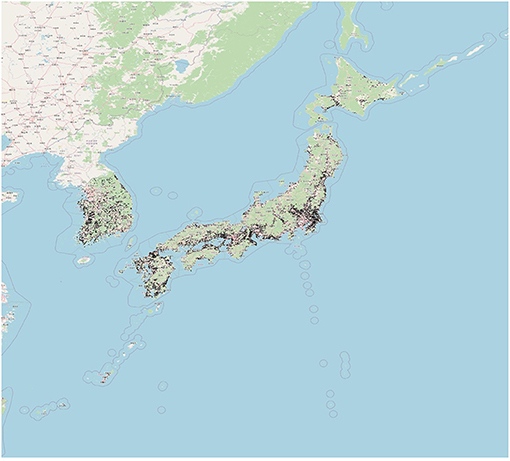
Figure 2. Data of solar PV power plant locations (displayed on the OpenStreetMap with QGIS). Source: Kim et al. (2020).
In Japan, there is no official GIS database showing where solar power plants are currently located. The Ministry of Economy, Trade and Industry has the information on the operators and date of approval that licenses solar power plant operators, but it is not disclosed in association with the GIS location information. Therefore, we made the judgement that the data used in Kim et al. (2021) was optimal for our analysis.
The data includes only medium-sized and larger solar PVs. The capacity of medium-scale solar PVs are larger than 500 kW and <10 MW, and that of large-scale solar PVs are >10 MW. As this study targets the disaster risks of medium- and large-scale solar PVs, small-scale solar PVs, including those on the rooftops of houses and factories are omitted.
The second data set used in this paper is the information about sediment-related disaster-prone areas of the Digital National Land Information provided by the Ministry of Land, Infrastructure, Transportation and Tourism of Japan4 (MLIT) (National Land Information Division, 2021b) (Figure 3). The information is in polygon style and is provided in the format of a shapefile. There are two types of areas covered, sediment disaster hazard areas and special hazard areas. According to the Act on Sediment Disaster Countermeasures for Sediment Disaster Prone Areas, sediment disaster hazard areas are areas where sediment disasters are likely to occur, with incidents of slope failures, landslides, and debris flows. The dataset includes all these three types of areas in a single dataset, and as such, there are some overlapping areas among them. Sediment disaster special hazard zones are areas with the risk of buildings being destroyed, which may cause severe injuries or fatalities to the residents (Disaster Management Bureau Cabinet Office of Japan., 2018). Sediment disaster hazard zones include all the areas of special hazard zones, so in this paper, we utilized the data of sediment disaster hazard zones. Data is provided by prefecture, and we used data from all 47 prefectures of Japan. The dataset we used was the latest dataset available, which was of August 2020.
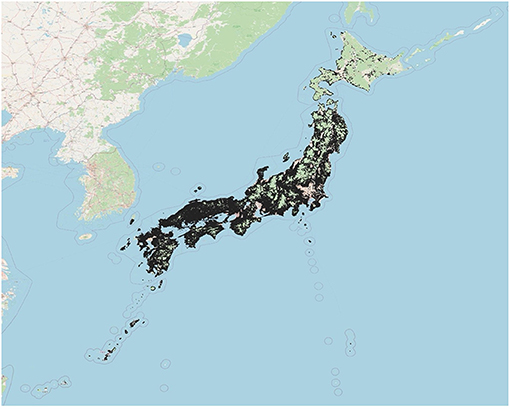
Figure 3. Data of sediment disaster hazard areas (displayed on the OpenStreetMap with QGIS). Source: Sedimental disaster prone areas by National Land Information Division, MLIT (2021).
The third data set is the floods and inundation hazardous area information of the Digital National Land Information from the MLIT (National Land Information Division, 2021a), in which the flood warning area in polygon data is included as a shapefile5 (Figure 4).
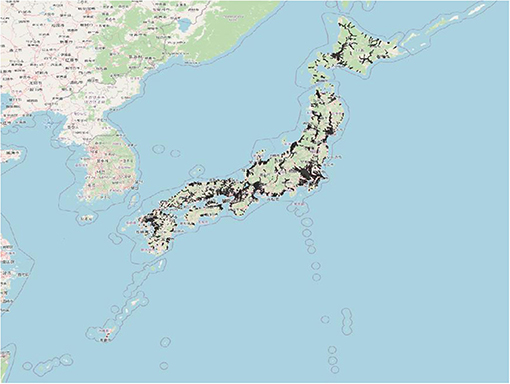
Figure 4. Data of floods and inundation hazard areas (displayed on the OpenStreetMap with QGIS). Source: Floods and inundation hazard areas by National Land Information Division, MLIT (2021).
Research Methods
As explained in the previous section, we used two polygon data, a sediment disaster hazard areas and flood and inundation hazard areas, as indicators related to disaster risks. We also used the location data of the solar power plants on GIS to find the number of points where the polygons overlap.
For the calculation, we used the overlap function in the GeoPandas library (https://geopandas.org/) of Python, a programming language often used for data analysis (Zhou et al., 2021). The function takes two parameters of polygon data and returns true when the two polygon data are combined and overlapped (Figure 5). We accumulated the number in which the function returned true, as seen in the basic function shown below (Figure 6). The two disaster datasets of each prefecture and the location data of the solar power plants were input as two variables. We also calculated the number of solar PV power plant areas overlapping with both the sediment disaster hazard areas and the flood and inundation hazard areas.
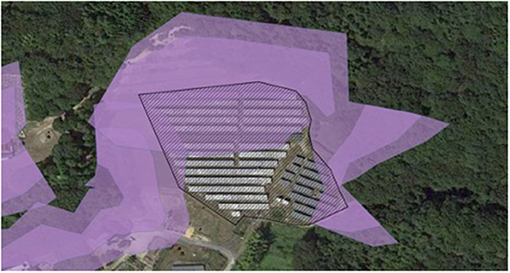
Figure 5. An example of overlapping solar PV area (black lines) with sedimental disaster prone area (purple) on Google Maps. Source: Created by the authors.
As explained above, the disaster data is separated for each prefecture, thus when formulating the program, we used the prefecture code starting from Hokkaido and ending with Okinawa to compare the disaster areas and the location of the solar power plants in order.
For data processing, both disaster-related data and solar power plant-related data used the shapefile format. For geocoding, EPSG: 4326, one of the standard geocoding systems, was used.
Results
As a result, we found the number of points where the sediment disaster hazard areas and the flood and inundation hazard areas in each prefecture overlap with the solar PV power plant locations. Our results are shown in Tables 2–4 for each prefecture with the total number calculated at the bottom.
In the dataset, the total number of the solar power plants in Japan was counted as 9,250 points. Among them, 782 points were found to overlap with the sediment disaster hazard areas in Japan as a whole, which is ~8.5% of the total (Table 2). Also, among all the solar PV power plant locations in Japan, the number of points overlapping with the flood and inundation hazard areas was 846. This represents about 9.1% of the total solar PV power plant locations in Japan (Table 3).
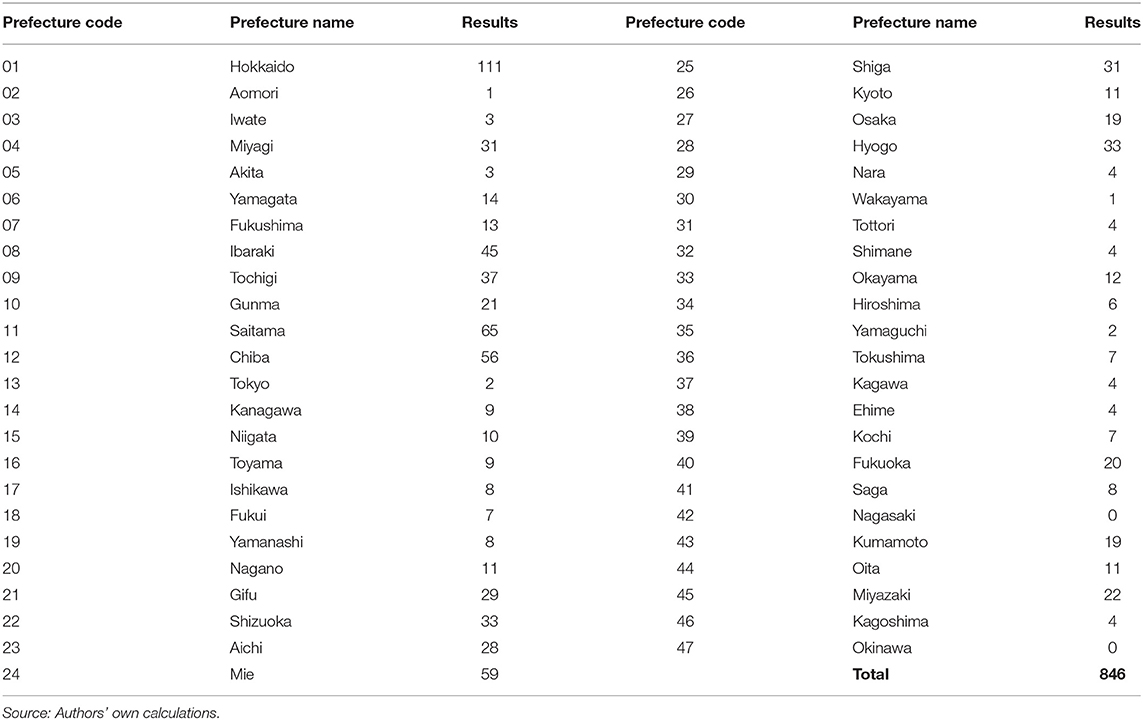
Table 3. Number of solar power plant locations overlapping with high flooding and inundation risk areas.
Also, there are 30 solar PV locations which overlap with both the landslides hazard areas and the floods and inundation hazard risk areas (Table 4). This means that about 0.3% of the total solar PV power plants are facing both the landslides risk and the floods and inundation risk.
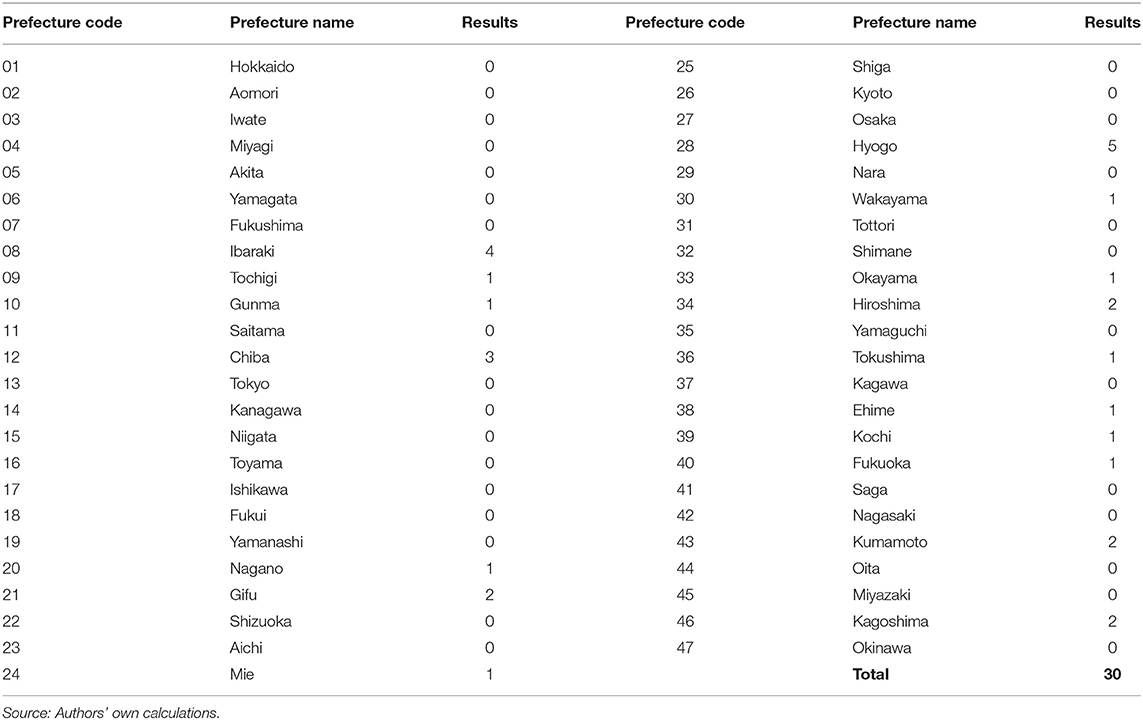
Table 4. Number of solar power plant locations overlapping with both high landslides risk areas and high flooding and inundation risk areas.
Discussion
Where to construct solar power plants is an important issue because the Japanese government policies aim to significantly increase the capacity of the solar power plants in the future. However, due to prevalence of mountainous areas in Japan, the flat land that could be used as a location for the solar PV power plants is limited. If the flat land where solar power plants can be easily built is exhausted, the next potential candidates will include mountainous or steep zones. In that case, before we start to select the sites for the future solar PV power plants, it is necessary to take into consideration not only the expected deforestation and other damages to the natural environment, but also the risks of sediment-related and of flood-related disasters.
In our study, we have shown that a number of the solar power plants in Japan are located in the sediment-related disaster and flood inundation hazard areas. Although it has been pointed out that site planning in consideration of disasters is important (Rediske et al., 2019), there have been few studies based on concrete calculations. If we look at the entire country of Japan, there has been no study done on the number of overlapping points between the location of solar power plants and the disaster risk areas. The findings of our research results show that the locations of a number of power plants overlap with the areas where sediment-related disasters and floods are highly likely to occur.
In relation to sediment-related disasters, it is necessary to consider the above risks when the demand for electricity derived from renewable energy sources increases in the future. In relation to flood disasters, the classification of solar PV power generation, i.e., whether it is classified as a rooftop solar PV or as an utility-scale solar PV, becomes an important issue. In areas with flood disaster risks, solar PV panels that are located on the rooftops of buildings are less likely to be damaged. On the other hand, for large-scale solar power plants located in flat areas, the flood disaster risks should be considered as an important factor to prevent future potential damage.
In our research, we focused on the solar PV power plants that have already been constructed. We have shown that a certain number of power plants that have already been constructed are located at points that are susceptible to sediment-related disasters or to flood hazards. We believe that our results are useful in suggesting that disaster risks should be taken into consideration when planning the locations of future solar power PV plants. As extreme weather events are likely to occur more frequently in the future, it will become even more important to consider disaster risk factors when selecting a power plant's location.
What could be some possible solutions regarding the location of solar power plants in Japan in the future? One possible solution is to build all new power plants in areas where there is no risk of disaster. However, that is not a realistic answer for future solar PV plant installations, as the future demand for renewable sourced energy is expected to rapidly increase. Another solution is to keep building solar power plants in disaster-risk areas but add some form of insurance against potential disasters. Based on the data about which areas could be highly impacted by disasters, we propose an insurance scheme for solar power plants in these high-risk areas. Our result potentially supports the development of insurance system for the solar PV power plant operators, as our study revealed that some solar PV power plants already locate in the disaster risk areas, and that the system can potentially be used the evaluation of the risk type and magnitude for solar PV upon conducting relevant improvement. The insurance could be provided by the government (central or local) or the private sector. The insurance scheme could promote a swift recovery from the damage caused by disasters and thus reduce the risks faced by solar power operators. We support the argument by Fraser (2019) that local governments can play an important role for an equitable and locally engaged energy transition.
In addition, as our results in Tables 2–4 show, the number of solar PV power plants located in high-risk areas displays a wide range of differences among prefectures. The prefectures have a variety of characteristics in their size, terrain, and amount of investment into solar PV. The local governments as well as private companies should properly identify these differences and consider expanding solar PV where suitable by taking into consideration the perspective of disaster prevention.
The risk of typhoons and strong winds was not included in our study. The reason is that, due to the wide range of typhoon potential paths, it is difficult to show the overlap between the typhoon risk and the location of the installed solar panels. However, as Ohgami (2019) shows, typhoons and strong winds can also lead to solar power plant accidents. Studies have also been conducted on the location and wind strength of solar power plants to conflict with potential wind farm locations (Obane et al., 2020). In future research, we believe that the risk of typhoons or strong winds for the location of the solar PV power plants should be studied as well.
The Law Concerning the Promotion of the Measures to Cope with Global Warming, which was revised in May 2021, has a provision saying that local prefectural governments should set goals and specify areas to promote renewable energy (Ministry of Environment of Japan, 2021a). It has been decided by an Ordinance of the Ministry of the Environment what locations should become the promotion areas for renewables. However, the Ministry of the Environment Ordinance does not exclude areas with high risk of disasters. At the time of writing (Nov. 2021), the Ministry of the Environment is planning to discuss with experts and decide a policy to exclude disaster risk areas from the promotion area of renewables (Ministry of Environment of Japan, 2021b). Therefore, our analysis of the overlap between the locations of the solar PV power plants and the disaster risk areas, could be also relevant for those forthcoming policy discussions.
Japan is a country where many natural disasters occur and where it is absolutely necessary to study the impact of disasters. However, we believe that research on the impact of natural disasters in Japan will be also relevant for countries where there have been few disasters so far due to the expected changes in the climate in the future. It will also serve as an important reference when promoting the solar PV power generation in developing countries where natural disasters due to climate change are expected to increase.
Conclusion
In this study, we performed a geographically-integrated analyses seeking for evaluating risks stemming from landslides and floods for the existing solar PV power plants in Japan. We compared the geographical data of disaster risks in Japan with the location data of solar PV power plants to investigate the number of solar PV power plants located in disaster risk areas by GIS-based integrated survey developed by authors. We focused on how many points overlap in the locations of the solar PV power plants constructed so far in Japan with the areas where there is a high risk of sediment-related disasters and of floods or inundation.
As a result, we counted the total number of the solar power plants in Japan as 9,250 points. Among them, 782 points were found to overlap with the sediment-related disaster hazard areas as a whole, which is ~8.5% of the total solar PV locations in Japan. Also, among all the solar PV locations, the number of points overlapping the flood and inundation hazard areas was 846. This is about 9.1% of the total number. Our results not only show that a significant number of solar power plants are located in the disaster risk areas, but also contribute to the discussion on future potential sites for solar PV installations.
A limitation of our study is that not all disaster risks were included in the analysis. We did not include the risks of typhoons and strong winds although typhoons and strong winds cause a large number of accidents at solar power plants. In addition, it could be said that areas with strong winds are also areas suitable for wind power generation. Further research on those issues is needed. For example, if we assume that the areas where maximum wind speed in the past exceeded a certain speed, which might damage solar PV power generation, are risky areas, the method used in this paper can be utilized to identify the risks from strong winds for the solar PV power plants.
Another possible direction for future research is to create framework that evaluates the degree of risk if the solar PV power plant is located in the landslides and floods hazard areas. In this research, we didn't evaluate the various degrees of risks. Future studies are needed, for example, to quantify the risks or calculate the potential costs of constructing solar PV in hazardous areas.
In addition, when applying this research to other regions or countries, it is necessary to have information on the locations of solar PV power plants and disaster risk information in those regions or countries. The information on the locations of solar power plants was limited even in the case of Japan. We believe that further data construction on solar power generation and disasters will be useful for future research, not only in Japan but around the world.
Data Availability Statement
Publicly available datasets were analyzed in this study. This data can be found here: https://nlftp.mlit.go.jp/ksj/index.html, https://doi.org/10.5281/zenodo.4644036.
Author Contributions
KH: conceptualization, methodology, data analysis, and writing original draft. DI and YY: conceptualization, reviewing, and editing. All authors contributed to the article and approved the submitted version.
Conflict of Interest
The authors declare that the research was conducted in the absence of any commercial or financial relationships that could be construed as a potential conflict of interest.
Publisher's Note
All claims expressed in this article are solely those of the authors and do not necessarily represent those of their affiliated organizations, or those of the publisher, the editors and the reviewers. Any product that may be evaluated in this article, or claim that may be made by its manufacturer, is not guaranteed or endorsed by the publisher.
Acknowledgments
The authors thank Dr. Kim Ji Yoon and other co-researchers who contributed to create the solar PV location dataset in Japan, and also thank Prof. Kitamoto Asanobu, who is the author of Electrical Japan, and his team for sharing an outstanding database of GIS based power plant information on their web site. The authors thank all those who worked to prepared disaster risk datasets on the digital national land information system, prepared by the Ministry of Land, Infrastructure, Transportation and Tourism of Japan. The authors also thank Ms. Cassandra Ling for the English proofreading.
Footnotes
1. ^Since this paper targets medium-scale (between 500 KW and 10 MW) and large-scale (above 10 MW) solar power generation, it does not cover small installation locations such as the rooftops of houses or factories.
2. ^http://agora.ex.nii.ac.jp/earthquake/201103-eastjapan/energy/electrical-japan/type/8.html.ja.
3. ^Available online: https://doi.org/10.5281/zenodo.4644036.
4. ^Available online: https://nlftp.mlit.go.jp/ksj/gml/datalist/KsjTmplt-A33-v1_4.html (in Japanese).
5. ^Available online: https://nlftp.mlit.go.jp/ksj/gml/datalist/KsjTmplt-A31-v2_2.html (in Japanese).
References
Agency for Natural Resources Energy. (2021b). Website for Feed-in Tariff Information. Available online at: https://www.fit-portal.go.jp/PublicInfoSummary (accessed on November 15, 2021).
Agency for Natural Resources Energy. (2021a). The 6th Strategic Energy Plan. Available online at: https://www.enecho.meti.go.jp/en/category/others/basic_plan/pdf/6th_outline.pdf (accessed on November 15, 2021).
Disaster Management Bureau Cabinet Office of Japan. (2018). Report on Flood and Sediment Disaster. Available online at: http://www.bousai.go.jp/kyoiku/pdf/h30_tebikisho_english.pdf (accessed on November 15, 2021).
Electrical Japan (2021). “Solar power plant locations,” in Japanese. Available online at: http://agora.ex.nii.ac.jp/earthquake/201103-eastjapan/energy/electrical-japan/type/8.html.ja (accessed on November 15, 2021).
Esteban, M., Zhang, Q., and Utama, A. (2012). Estimation of the energy storage requirement of a future 100% renewable energy system in Japan. Energy Policy 47, 22–31. doi: 10.1016/j.enpol.2012.03.078
Fraser, T. (2019). How governance and disasters shape renewable energy transitions: the case of Japanese mega-solar. Soc. Sci. Q. 100, 975–990. doi: 10.1111/ssqu.12603
Itaka, S. (2021). Economic Analysis of Cedar Plantation Management and Mega-Solar Replacement. Forests 12:361. doi: 10.3390/f12030361
Kim, J. Y., Koide, D., Ishihama, F., Kadoya, T., and Nishihiro, J. (2020). “Solar PV data: Current site planning of medium to large solar power systems accelerates the loss of the remaining semi-natural and agricultural habitats [Data set],” in Science of the Total Environment Zenodo, 146475.
Kim, J. Y., Koide, D., Ishihama, F., Kadoya, T., and Nishihiro, J. (2021). Current site planning of medium to large solar power systems accelerates the loss of the remaining semi-natural and agricultural habitats. Sci. Total Environ. 779:146475. doi: 10.1016/j.scitotenv.2021.146475
Kwon, D., Bunme, P., and Mitani, Y. (2020). “Extraction of solar photovoltaic power plants in disaster areas using GIS and construction of a method for proposing safe and efficient solar photovoltaic power plants installation locations,” in Japanese. Joint Conference of Electrical, Electronics and Information Engineers in Kyushu, 470–471.
Li, A., and Xu, Y. (2019). The governance for offshore wind in Japan. Energy Procedia 158, 297–301. doi: 10.1016/j.egypro.2019.01.092
Li, A., Xu, Y., and Shiroyama, H. (2019). Solar lobby and energy transition in Japan. Energy Policy 134:110950. doi: 10.1016/j.enpol.2019.110950
Ministry of Economy Trade Industry (METI). (2019). Report on the Recent Trends and Future Directions Regarding Solar cell Power Generation Facilities. Available online at: https://www.meti.go.jp/shingikai/sankoshin/hoan_shohi/denryoku_anzen/newenergy_hatsuden_wg/pdf/015_03_00.pdf (accessed on November 15, 2021).
Ministry of Environment of Japan. (2019). Report of the Study Group on the Basic Concept of Environmental Impact Assessment for Solar Power Generation Facilities. Available online at: https://www.env.go.jp/press/files/jp/110948.pdf (accessed November 15, 2021).
Ministry of Environment of Japan. (2021a). About the Cabinet Decision to Amend a Part of the Law Concerning the Promotion of the Measures to Cope with Global Warming. Retreived from: http://www.env.go.jp/press/109218.html (accessed November 15, 2021).
Ministry of Environment of Japan. (2021b). Expectations and Issues Regarding Future Local Government Implementation Plans. Retreived from: https://www.env.go.jp/policy/council/52keikaku-manual/y520-01b/mat04_1-1-3.pdf (accessed November 15, 2021).
National Land Information Division National Spatial Planning, and Regional Policy Bureau MLIT of Japan. (2021b). “Sedimental disasters prone areas,” in Japanese. Available online at: https://nlftp.mlit.go.jp/ksj/gml/datalist/KsjTmplt-A33-v1_4.html (accessed November 15, 2021).
National Land Information Division National Spatial Planning, and Regional Policy Bureau MLIT of Japan. (2021a). “Floods and inundation hazardous areas,” in Japanese. Available online at: https://nlftp.mlit.go.jp/ksj/gml/datalist/KsjTmplt-A31-v2_2.html (accessed November 15, 2021).
Obane, H., Nagai, Y., and Asano, K. (2020). Assessing land use and potential conflict in solar and onshore wind energy in Japan. Renewable Energy 160, 842–851. doi: 10.1016/j.renene.2020.06.018
Ohgami, H. (2019). Incidents of accident damages caused by natural disasters at solar power plants. J. Japan Soc. Mater. Cycles Waste Manage. 30, 408–412. doi: 10.3985/mcwmr.30.408
Rediske, G., Siluk, J. C. M., Gastaldo, N. G., Rigo, P. D., and Rosa, C. B. (2019). Determinant factors in site selection for photovoltaic projects: A systematic review. Int. J. Energy Res. 43, 1689–1701. doi: 10.1002/er.4321
Sahu, A., Yadav, N., and Sudhakar, K. (2016). Floating photovoltaic power plant: a review. Renew. Sustain. Energy Rev. 66, 815–824. doi: 10.1016/j.rser.2016.08.051
Tabata, T. (2019). Damage to the solar photovoltaic power generation system due to natural disasters. Proceed. Japan Soc. Mater. Cycles Waste Manag. 30:13.
Keywords: solar PV, location of solar PV power plants, hazard map, disaster risks, GIS
Citation: Hao K, Ialnazov D and Yamashiki Y (2021) GIS Analysis of Solar PV Locations and Disaster Risk Areas in Japan. Front. Sustain. 2:815986. doi: 10.3389/frsus.2021.815986
Received: 16 November 2021; Accepted: 23 November 2021;
Published: 21 December 2021.
Edited by:
Alexander Ryota Keeley, Kyushu University, JapanReviewed by:
Yuki Ishimoto, Institute of Applied Energy, JapanJunya Kumagai, Kyushu University, Japan
Copyright © 2021 Hao, Ialnazov and Yamashiki. This is an open-access article distributed under the terms of the Creative Commons Attribution License (CC BY). The use, distribution or reproduction in other forums is permitted, provided the original author(s) and the copyright owner(s) are credited and that the original publication in this journal is cited, in accordance with accepted academic practice. No use, distribution or reproduction is permitted which does not comply with these terms.
*Correspondence: Kazuki Hao, aGFvLmthenVraS43NXdAc3Qua3lvdG8tdS5hYy5qcA==
 Kazuki Hao
Kazuki Hao Dimiter Ialnazov
Dimiter Ialnazov Yosuke Yamashiki
Yosuke Yamashiki

